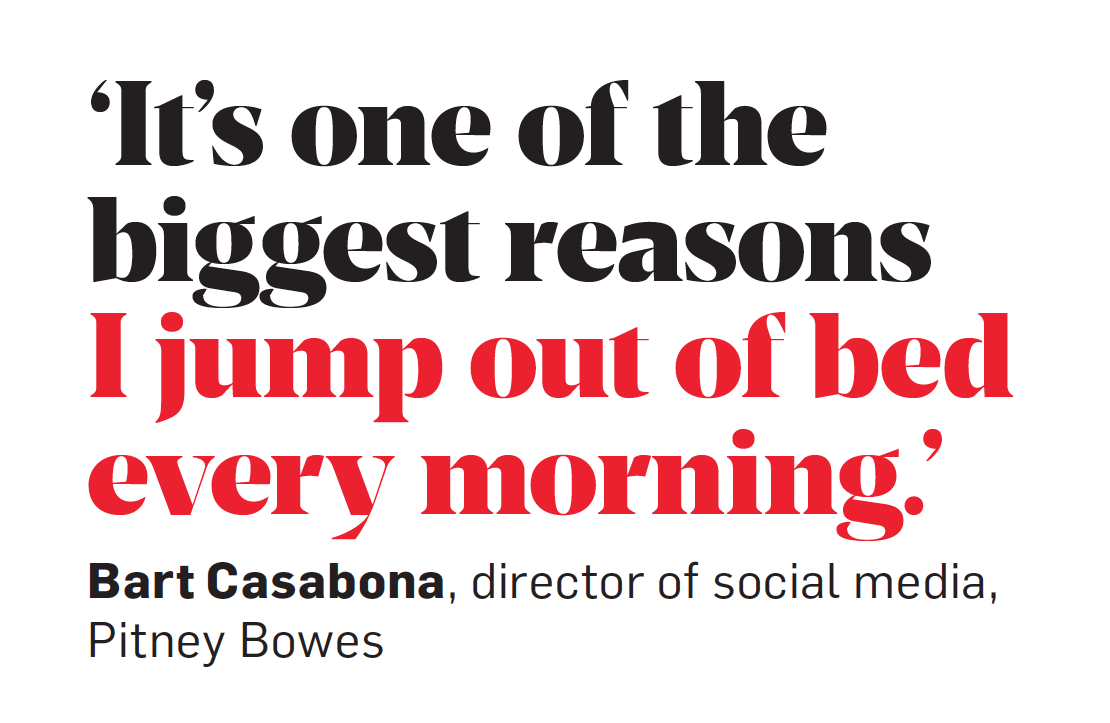Big Brands Are Enlisting Employees to Create an Army of Social Media Mavens. Humana encourages employees to socialize health-minded content. "We are hoping to build on that," remarked Susan Warner, vp of worldwide communications for MasterCard. Last year, IBM got everyone's attention when it dispatched 1,000 employees to work on social media marketing. "We look to the employees and give them recognition," said Casabona. Humana now has about 2,900 employees involved with its own advocacy program, which only had 500 members at the beginning of the year. Focusing on content style and giving employees "an expert voice" on how to handle Twitter and Facebook posts are keys to success, according to Jason Spencer, the healthcare company's social media community manager. "Forty percent of our content is Humana branded," he explained. So when they do share Humana content, they have a more qualified audience." "But we are getting more engagement, more clicks, on Twitter."

Maggie Huber/Courier Journal
If you are a marketing chief, one of the best return-on-investment channels may actually include your colleagues. Increasingly, marketers are turning their employees into social media mavens, encouraging them to promote positive, intriguing or helpful stories that are on-brand.
This past summer, MasterCard quietly launched an ambassador program that had employees share brand-minded news and other content across their personal social channels. The endeavor already has attracted 400 of its staffers, who use a company intranet that lets them post text, images and videos to Facebook, Twitter and LinkedIn.
"We are hoping to build on that," remarked Susan Warner, vp of worldwide communications for MasterCard. "It’s all about technology. I do have to figure out infrastructural costs and implementation, but you cannot let those issues hold you back. You have to build the case and then get the dollars."
Last year, IBM got everyone’s attention when it dispatched 1,000 employees to work on social media marketing.
A study released in March by Altimeter Group found that 90 percent of brands already used or planned to pursue an employee advocacy program. Among the findings: Twenty-one percent of consumers said they "liked" employee posts about companies, representing an engagement rate that easily bests most social advertising campaigns at a much lesser cost.
"It is not expensive," noted Bart Casabona, director of social media at Pitney Bowes. "It’s one of the biggest reasons I jump out of bed every morning."

Casabona has found the organic reach of his company’s employee-based program, called The Insiders, to be extremely impactful. The number of participating employees has grown to 500 after emerging from a pilot phase in January, and he projects that number to rise to between 750 and 1,000 by the end of 2016. The Insiders include employees around the world, from the United States to the United Kingdom, India, New Zealand, Australia and Germany. So far, Casabona’s effort has generated 42,000 content shares and 166 million digital impressions. "This is a program that continues to pick up pace," he remarked.
So, what’s the incentive to participate? A simple leaderboard, believe it or not. "We look to the employees and give them recognition," said Casabona. "We are giving them the opportunity to put their imprint on the program, which makes it more compelling."
The strategy is centered around brand marketing, say marketers, so sales data takes a back seat.
Humana now has about 2,900 employees involved with its own advocacy program, which only had 500 members at the beginning of the year. Focusing on content style and giving employees "an expert voice" on how to handle Twitter and Facebook posts are keys to success, according to Jason Spencer, the healthcare company’s social media community manager.
"Forty percent of our content is Humana branded," he explained. "Sixty percent is health and well-being content, which allows [employees] to grow followers and become influencers in the space. So when they do share Humana content, they have a more qualified audience."
Humana, being a healthcare brand, has, of course, strict regulations to abide by for its content. It’s using Dynamic Signal’s software, which tees up a legal message, an image and a hashtag to make things easy for the company’s busy staffers. A lot of the content deals involve potentially helpful information about hospitals and health trends, and the brand recently expanded its program to Instagram.
"Most advocates are [primarily] sharing on Facebook," Spencer revealed. "But we are getting more engagement, more clicks, on Twitter."
As inspiring as these programs are, there always will be employees who would prefer to opt out, but can they really? "No one likes to be told what to do to have fun or how to build work relationships, just like they don’t like being told how to feel or how to pretend to feel," said Gianna Scorsone, vp of sales ops and marketing for human-resources agency Mondo. "Implementing these types of programs internally gives that experience back to the employee and creates a sense of ownership to the culture itself. You own it, you don’t like [it]—then do something about it."
This story first appeared in the October 24, 2016 issue of Adweek magazine.
Click here to subscribe.
COMMENTS